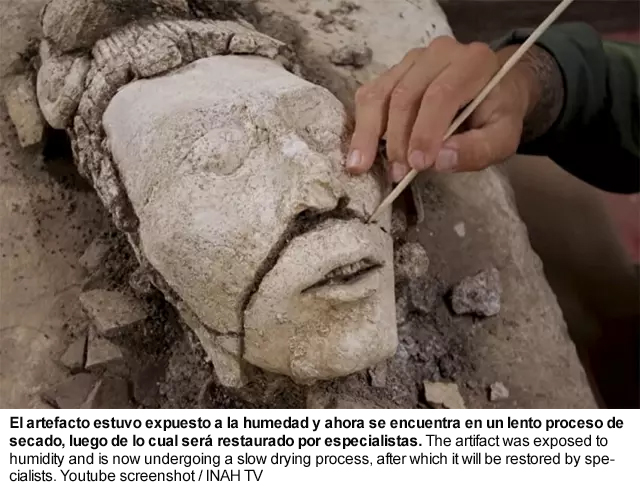The sculpture lay hidden for more than 1,000 years
by Mexico News Daily
An approximately 1,300-year-old sculpture of the head of the Maya maize god has been uncovered at the Palenque archaeological site in the southern state of Chiapas.
Experts with the National Institute of Anthropology and History (INAH) found the effigy of the young god last year but the discovery wasn’t reported until this week. INAH said in a statement that it was the first time that a stucco head of the important Maya deity had been found at Palenque, which started out as a village around 150 B.C. before becoming a powerful Maya city.
An interdisciplinary team working on a United States government-funded conservation project found the sculpture last July in the Palace, a large, elevated complex of several connected and adjacent buildings and courtyards.
“The team … observed a careful alignment of stones while removing the filler in a corridor that connects rooms of House B of the Palace to those of the adjacent House F. Inside a semi-square receptacle … and beneath a layer of loose dirt the nose and partially open mouth of the divinity emerged,” INAH said.
“As the exploration advanced it was confirmed that the sculpture is the centerpiece of a rich offering that was placed over a pool with a stuccoed floor and walls … to emulate the entry of this god to the underworld in an aquatic setting.”
INAH Chiapas researcher Arnoldo González Cruz said the discovery “allows us to begin to understand how the ancient Maya of Palenque constantly relived the mythical … [story] about the birth, death and resurrection of the maize god.”
The length of the stucco head is 45 centimeters while its width is 16 centimeters. It was found lying in an east to west position, “which would symbolize the birth of the corn plant with the first rays of the sun,” INAH said. Experts described the maize god’s facial features as “graceful.”
“The chin is pointed, pronounced and split [and] the lips are thin and project outwards,” said González and two of his colleagues, according to the INAH statement. “… The cheekbones are smooth and rounded and the eyes are long and thin. From a broad, long, flat and rectangular forehead a wide and pronounced nose grows.”
The sculpture, “conceived originally as a severed head,” was found on a broken “tripod plate” made from clay, INAH said. “Due to the ceramic type of the tripod plate that accompanies the head of the young, tonsured maize god … the archaeological context has been dated to the late classic period (A.D. 700-850).”
INAH said that vegetable matter, bones of various animals including turtles, quail and domestic dogs, shells, crab claws, ceramic pieces, miniature anthropomorphic figurines and pieces of obsidian blades and seeds among other items were also deposited in a closed-off compartment where the sculpture – which lay hidden for about 1,300 years – was found.
“The positioning of these elements was … concentric, … covering 75 percent percent of the cavity, which was sealed with loose stones,” González said.
“Some animal bones had been cooked and others have … teeth marks,” he said, explaining that indicated that meat was eaten by the inhabitants of Palenque as part of a ritual.
The maize god head was exposed to humidity and is currently undergoing a process of gradual drying, INAH said, adding that it will subsequently be restored by specialists.



